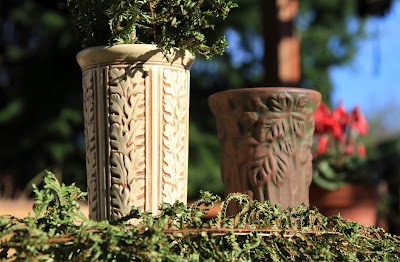In this installment of the pots and plants series we have a Dryopteris - wood fern - with two different vases: a Weller Clinton Ivory Vase and a Peters and Reed Moss Aztec Vase. We cut the Dryopteris a week earlier during some yard cleaning which explains its dried look in the photos. Wood ferns are common in the Northern Hemisphere.
First, a confession. We thought his was Polystichum polyblepharum - Tassel Fern - for the longest time. The ends of the pinnae and the blade itself have what look like “tassels” to us – hence the confusion - but really, the form is called cresting. (There is a good explanation of fern structures and what you call the parts of a fern at Native Plants for Georgia: Part 2 - Ferns.) We take comfort in the 1906 publication Gardeners’ chronicle, horticultural trade journal where, on page 27, we see the reference to tassels at the tips. Phew.
Anyhow, from our new best friend Quattrocchi [CRC World Dictionary of Plant Names - Who is Umberto Quattrocchi?] we were going to say that the generic name Polystichum comes from the Greek polys “many” and stichos “a row, series” referring to the sori (singular sorus) in many rows. The specific name ploybelpharum means many eyelashed, many fringed [DG] and refers to the bristly scales located along the mid-veins and pinnules. (Now, blepharitus, the inflammation of the eyelash follicles has a whole new significance.) The common name comes from the appearance of the fronds as they unfurl, looking droopy like tassels.
The last bit about the unfurling of the fronds giving rise to the common name Tassel Fern was the first hint that maybe it wasn’t P. polyblepharum. That tidbit along with the generic naming referring to rows of sori made us pause. (The arrangement of the sori is a key identification feature of ferns.) So the doubt entered our minds, we went to see Pina (the Wim Wenders movie about Pina Bausch (1940 - 2009)), came home, and realized it was Dryopteris. Pina helped us understand the pinna - so to speak. Case closed, or sort of. What species is it? (Boy is our record keeping spotty!) By the looks of it, it looks pretty close to Dryopteris affinis ‘Cristata’ 
Other terms to keep in mind when thinking about ferns are ramenta and pinnules. Ramenta are the yellow-brown scales on the rachis (part of the stem of the frond). Wood ferns like D. affinis have ramenta as shown here. The pinnules are a secondary division of the pinnae - a leaflet of sorts. In D. affinis they are broadly rectangular with slightly serrated edges.
The specimen that the fronds in the photos come from is grown in a large clay pot under the cover of pear trees with sun-dappled shade. It has what seems to be called a ‘shuttlecock’ type of growth pattern that looks like a badminton birdie. It reaches several feet in height and width. The fronds are usually trashed by mid-winter so we typically remove all the fronds and let it start from scratch.
Okay, so back to Quattrocchi, where we find that Dryopteris comes from the Greek dryopteris (drys “oak, a wood” and pteris “fern”) given to the genus by Dioscorides to a black oak-fern, Asplenium onopteris. And, from Latin dryopteris for a plant similar to dryophonon “a sort of fern” a name given by Plinius. We decided to see if we could confirm this last tidbit of information. We found a copy of the reference Michel Adanson (1727 - 1806), Familles de plantes 2:20 at the Internet Archive (www.archive.org) and tried to look it the fact. Well, we found Dryopteris on page 20, but it’s not until you go to a table of names in the second part (2:560) that you see a mention of Plinius but under a different plants Gale (Myrica gale?). It was confusing to tease apart and figure out how Quattrocchi arrived at the statement, so let’s get on with this post and talk about pots. (Affinis means related to or like another species.)
The vases are thematically related in that they both were made by pottery companies at the beginning of the 20th century in Zanesville, Ohio. (There must be Dryopteris in Ohio?)
The Weller Clinton Ivory Vase we purchased a few years ago in an antique mall in Connecticut. It is about 9” tall and 4 ½” across at the top. It is an ivory color and is not signed. The Weller Pottery of Zanesville, Ohio was a prolific creator of high-end art pieces and functional commercial ware. This vase seems to be from the “middle” period of the Clinton Ivory line, circa 1915.
The Peters and Reed Moss Aztec vase we purchased a dozen or so years ago in a Pioneer Square antique shop. It was described to us as being made between 1905 and 1912, 7 ½” tall, 4 ½” across at the top. The vase is brown and moss green finish and the bottom is not signed. Peters and Reed Pottery (1897 - 1919) was bought out in 1920 and renamed Zane Pottery of Zanesville, Ohio.
Sori on the Back for a Dryopteris Frond and Excerpt from Gardeners’ chronicle, horticultural trade journal, 1906

Dryopteris affinis ‘Cristata’ Frond Parts Up Close (No Sori), Ramenta
Fern Crests – Dryopteris








This is a pearafanilia!!!!!!!
ReplyDelete